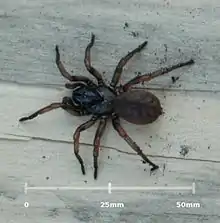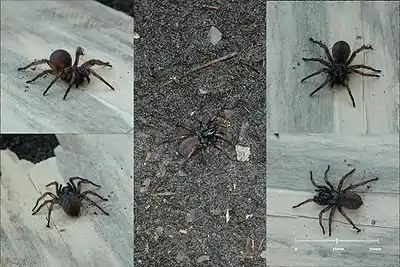Stanwellia
Stanwellia is a genus of South Pacific araneomorph spiders in the family Pycnothelidae. It was first described by W. J. Rainbow & R. H. Pulleine in 1918.[3] Originally placed with the curtain-web spiders,[3] it was transferred to the funnel-web trapdoor spiders in 1985,[4] then to the Pycnothelidae in 2020.[5] It is a senior synonym of Aparua.[2]
| Stanwellia | |
|---|---|
 | |
| Melbourne trapdoor spider (Stanwellia grisea) | |
| Scientific classification | |
| Kingdom: | Animalia |
| Phylum: | Arthropoda |
| Subphylum: | Chelicerata |
| Class: | Arachnida |
| Order: | Araneae |
| Infraorder: | Mygalomorphae |
| Family: | Pycnothelidae |
| Genus: | Stanwellia Rainbow & Pulleine, 1918[1] |
| Type species | |
| S. hoggi (Rainbow, 1914) | |
| Species | |
|
18, see text | |
| Synonyms[1] | |
| |
Species

Melbourne Trapdoor Spider: Composite image of same spider from various angles. Center image as seen in natural surroundings (sandy loam soil). Location: found in moist soil at Carnegie, Melbourne, Victoria, Australia.
As of June 2020 it contains eighteen species, found in New Zealand and Australia:[1]
- Stanwellia annulipes (C. L. Koch, 1841) – Australia (Tasmania)
- Stanwellia bipectinata (Todd, 1945) – New Zealand
- Stanwellia grisea (Hogg, 1901) – Australia (Victoria)
- Stanwellia hapua (Forster, 1968) – New Zealand
- Stanwellia hoggi (Rainbow, 1914) (type) – Australia (New South Wales)
- Stanwellia hollowayi (Forster, 1968) – New Zealand
- Stanwellia houhora (Forster, 1968) – New Zealand
- Stanwellia inornata Main, 1972 – Australia (Victoria)
- Stanwellia kaituna (Forster, 1968) – New Zealand
- Stanwellia media (Forster, 1968) – New Zealand
- Stanwellia minor (Kulczyński, 1908) – Australia (New South Wales)
- Stanwellia nebulosa (Rainbow & Pulleine, 1918) – Australia (South Australia)
- Stanwellia occidentalis Main, 1972 – Australia (South Australia)
- Stanwellia pexa (Hickman, 1930) – Australia (Tasmania)
- Stanwellia puna (Forster, 1968) – New Zealand
- Stanwellia regia (Forster, 1968) – New Zealand
- Stanwellia taranga (Forster, 1968) – New Zealand
- Stanwellia tuna (Forster, 1968) – New Zealand
See also
References
- "Gen. Stanwellia Rainbow & Pulleine, 1918". World Spider Catalog Version 20.0. Natural History Museum Bern. 2020. doi:10.24436/2. Retrieved 2020-07-11.
- Main, B. Y. (1983). "Further studies on the systematics of Australian Diplurinae (Chelicerata: Mygalomorphae: Dipluridae): Two new genera from south Western Australia". Journal of Natural History. 17: 923.
- Rainbow, W. J.; Pulleine, R. H. (1918). "Australian trap-door spiders". Records of the Australian Museum. 12: 81–169.
- Raven, R. J. (1985). "The spider infraorder Mygalomorphae (Araneae): Cladistics and systematics". Bulletin of the American Museum of Natural History. 182: 82.
- Opatova, V.; et al. (2020). "Phylogenetic systematics and evolution of the spider infraorder Mygalomorphae using genomic scale data". Systematic Biology. 69 (4): 701. doi:10.1093/sysbio/syz064.
Further reading
- Main, B. Y. (1972). "The mygalomorph spider genus Stanwellia Rainbow & Pulleine (Dipluridae) and its relationship to Aname Koch and certain other diplurine genera". Journal and Proceedings of the Royal Society of Western Australia. 55: 100–114.
- Forster, R. R. (1968). "The spiders of New Zealand. Part II. Ctenizidae, Dipluridae". Otago Museum Bulletin. 2: 126–180.
- Hogg, H. R. (1901). "On Australian and New Zealand spiders of the suborder Mygalomorphae". Proceedings of the Zoological Society of London. 71 (1): 218–279.
- Raven, R. J. (1981). "A review of the Australian genera of the mygalomorph spider subfamily Diplurinae (Dipluridae: Chelicerata)". Australian Journal of Zoology. 29: 321–363.
External links
- Melbourne Trapdoor spider
- Melbourne Trap-door Spider Stanwellia grisea
- Victorian Funnel web, Trap-door spiders and Mouse spiders. Which spiders do Victorians mistake for a Sydney Funnel-web?
This article is issued from Wikipedia. The text is licensed under Creative Commons - Attribution - Sharealike. Additional terms may apply for the media files.